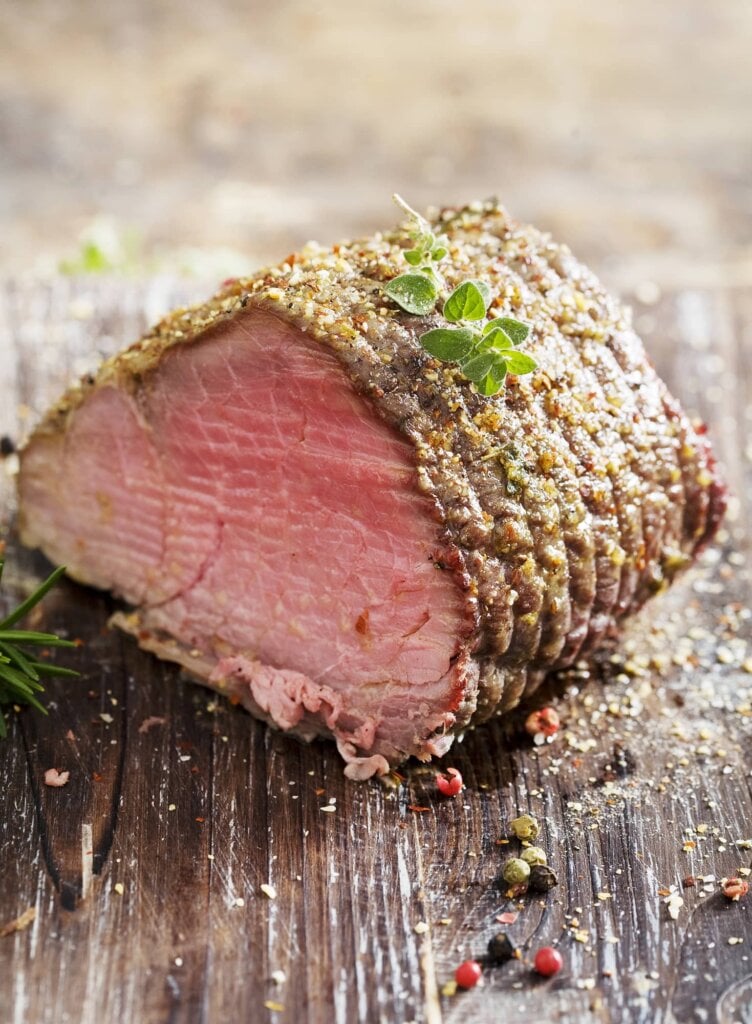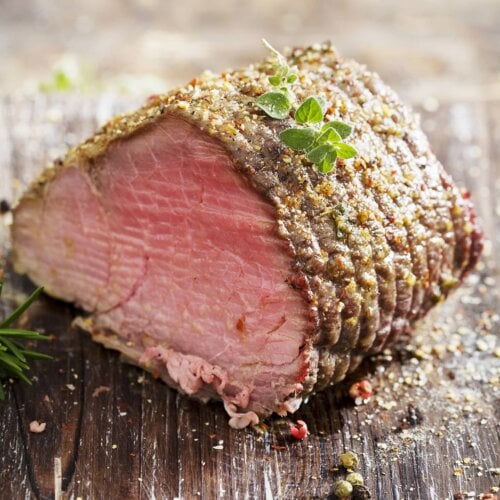
Beef roasts tend to cost surprisingly little per pound because they’re not quite as easy to cook up as steaks or chops. However, you can easily transform a large hunk of beef into an amazing meal just through the power of brining. The key is combining the right amount of salt with water and flavorful liquids to help enhance the natural beef taste. Some cooking methods also work better for brined beef roasts than others. Become an expert in brining a beef roast with this guide to all the steps.
Understanding Brining
Brining is one of those food preparation methods that is often misunderstood and misapplied, not unlike marinating. Find out the facts and how to best use this pre-cooking step for the best benefits.
What is Brining?
The term brining refers to soaking something in a salt and water solution. A certain amount of salt is required to help the liquid penetrate the beef roast or other items soaking in the brine. Brining is used to add flavor and juiciness to meats like beef and is commonly used by popular restaurant chains for chicken breasts in particular.
How Brining Works
The key to a brine is salt, and using too little salt will only leave the liquid unable to penetrate the surface of the melt. It’s the sodium level that helps the liquids enter the meat and soak into individual cells to add flavor and change the texture of the cooked beef. Skipping sources of salt, whether that’s Kosher salt in granules or another source like soy sauce, will only leave the beef less flavorful and slightly tougher. However, more salt is not better either. Using near the recommended amount from a brine recipe ensures you get good flavor without overt saltiness.
Importance of Brining in Cooking Beef Roast
Brining a beef roast helps bring flavor to the center of the meat. Thinner cuts like steaks are easy to coat on the surface, but a large piece of meat like a standing rib roast isn’t that easy to season from the exterior alone. Soaking the roast in brine can also help soften the meat slightly, although this isn’t usually enough to make much of a noticeable difference in the average roast. You’ll need to rely on the right cooking method based on the cut of meat to get tender and not tough results.
Selecting Beef Roast
Choosing the Right Cut for Brining
Larger beef roasts respond better to brining than smaller ones. Thin flank roasts may get too salty if brined, but they can be marinated in a mixture with a lower salt concentration. Thick roasts with at least one to two inches of meat in the thinnest parts will absorb the brine without getting too salty. Briskets, top round, rump roasts, chuck roasts, standing rib roasts, and any other cuts used for roast beef all work well for brining.
Factors to Consider When Buying a Beef Roast
Look for Prime-rated roasts that have been well-trimmed of fat. A small fat cap is fine, but the majority of the meat needs to be exposed so the brine liquid can penetrate the surface.
Brining Ingredients
Each brine is unique, but some ingredients can’t be excluded or replaced as easily as others.
Essential Ingredients for Brine
Salt is perhaps the only essential ingredient for brine other than water. The first brines and marinades used for meats were made with seawater, so you can mimic the effect by mixing your favorite non-iodized salt and water alone. Throwing in other sources of sodium and flavoring agents will make the brine even more useful for spicing up your beef roast.
Exploring Different Salts and Their Effects
Kosher salt or sea salt are the best types of salt for brines and cooking in general. Iodized and table salts feature anti-caking agents that can affect the color and flavor of the cooked beef roast. Most recipes are based on Kosher salt measurements, so swapping out pink salt or fine sea salt could change the concentration of sodium in the brine. Make sure to use a conversion tool if you’re swapping out the salt type.
Additional Flavoring Agents for Brine
Brine liquid offers some of the same benefits as a marinade when you add in plenty of flavoring ingredients. Common liquid additions include brewed coffee, Worcestershire sauce, soy sauce, mirin, wine, beer, or tomato juice. Along with the salt, you may want to toss minced garlic, whole rosemary sprigs, powdered herbs and spices, and cracked black peppercorns in the brine.
Cooking Brined Beef Roast
Cooking Techniques Suitable for Brined Beef
Roasting: Roasting is a classic method for cooking beef roast. Preheat your oven to the desired temperature (usually around 350°F to 400°F or 175°C to 200°C). Place the beef roast on a roasting rack in a roasting pan and cook it until it reaches your desired level of doneness. Basting the roast with pan juices or broth occasionally can help keep it moist and flavorful.
Grilling: Grilling can add a delicious smoky flavor to your brined beef roast. Preheat your grill to medium-high heat. Pat the beef roast dry with paper towels and brush it lightly with oil to prevent sticking. Grill the roast, turning occasionally, until it reaches your desired level of doneness. Use a meat thermometer to ensure it’s cooked to the correct temperature.
Slow Cooking: Slow cooking is perfect for tenderizing tougher cuts of beef roast. After brining, place the beef roast in a slow cooker along with your choice of aromatics, such as onions, garlic, and herbs. Cook on low heat for several hours until the meat is fork-tender and flavorful.
Searing and Braising: Searing the beef roast before braising adds flavor and helps to seal in the juices. Heat a large skillet over medium-high heat, add some oil, and sear the beef roast on all sides until browned. Then, transfer the roast to a braising pot or Dutch oven along with broth or wine and any desired vegetables or aromatics. Cover and cook in the oven at a low temperature until the meat is tender.
Smoking: If you have a smoker, smoking your brined beef roast can impart a rich, smoky flavor. Follow the manufacturer’s instructions for your smoker and cook the roast until it reaches your desired level of doneness, typically several hours at a low temperature.
Simple Beef Roast Brine Recipe
Ingredients:
- 1 gallon (about 4 liters) of water
- 1 cup kosher salt
- 1/2 cup brown sugar
- 1 tablespoon whole black peppercorns
- 4 cloves garlic, smashed
- 2 bay leaves
- 2 sprigs of fresh thyme
- 1 onion, sliced
- 1 lemon, sliced
- Optional: other herbs and spices such as rosemary, sage, or juniper berries according to taste
Instructions:
- In a large pot, combine water, kosher salt, brown sugar, peppercorns, garlic, bay leaves, thyme, onion, and lemon slices. Bring the mixture to a simmer over medium heat, stirring occasionally until the salt and sugar are completely dissolved. Let it cool to room temperature.
- Once the brine has cooled, place your beef roast in a large, sturdy plastic bag or non-reactive container. Pour the brine over the beef roast, ensuring that it is completely submerged. If needed, you can weigh the roast down with a plate to keep it submerged.
- Seal the bag or cover the container and place it in the refrigerator. Let the beef roast brine for at least 12 hours or up to 24 hours for best results.
- After brining, remove the beef roast from the brine and rinse it thoroughly under cold water to remove any excess salt. Pat it dry with paper towels.
- Now you can cook your beef roast using your preferred method, whether it’s roasting, grilling, slow cooking, searing, braising, or smoking. The brining process will help to infuse the meat with flavor and keep it juicy and tender.
Simple Beef Roast Brine – Nutritional Facts
Estimated Per Serving (Based on a 2,000-Calorie Daily Diet and brine absorption)
| Nutrient | Amount (% DV) |
|---|---|
| Calories | 10 |
| Total Fat | 0g (0%) |
| Saturated Fat | 0g (0%) |
| Cholesterol | 0mg (0%) |
| Sodium | 350mg (15%) |
| Total Carbohydrate | 2g (1%) |
| Dietary Fiber | 0g (0%) |
| Sugars | 2g |
| Protein | 0g (0%) |
| Iron | 0mg (0%) |
| Vitamin C | 0mg (0%) |
| Calcium | 2mg (0%) |
| Potassium | 10mg (0%) |
Conclusion
Experiment with brining recipes to bring out new depths of flavor from your favorite beef roasts. No smoked brisket or standing rib roast is complete without the addition of a soak in some salted water.

Simple Beef Roast Brine
Ingredients
- 1 gallon water
- 1 cup kosher salt
- 1/2 cup brown sugar
- 1 tbsp whole black peppercorns
- 4 cloves garlic, smashed
- 2 bay leaves
- 2 sprigs fresh thyme
- 1 onion, sliced
- 1 lemon, sliced
- optional: other herbs and spices like rosemary, sage, or juniper berries according to taste
Instructions
- In a large pot, combine water, kosher salt, brown sugar, peppercorns, garlic, bay leaves, thyme, onion, and lemon slices. Bring the mixture to a simmer over medium heat, stirring occasionally until the salt and sugar are completely dissolved. Let it cool to room temperature.
- Once the brine has cooled, place your beef roast in a large, sturdy plastic bag or non-reactive container. Pour the brine over the beef roast, ensuring that it is completely submerged. If needed, you can weigh the roast down with a plate to keep it submerged.
- Seal the bag or cover the container and place it in the refrigerator. Let the beef roast brine for at least 12 hours or up to 24 hours for best results.
- After brining, remove the beef roast from the brine and rinse it thoroughly under cold water to remove any excess salt. Pat it dry with paper towels.
- Now you can cook your beef roast using your preferred method, whether it's roasting, grilling, or slow cooking. The brining process will help to infuse the meat with flavor and keep it juicy and tender.

